上海牛津7Bwater festival公开课
- 格式:ppt
- 大小:8.54 MB
- 文档页数:22
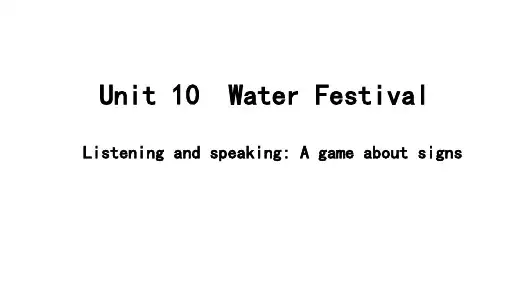
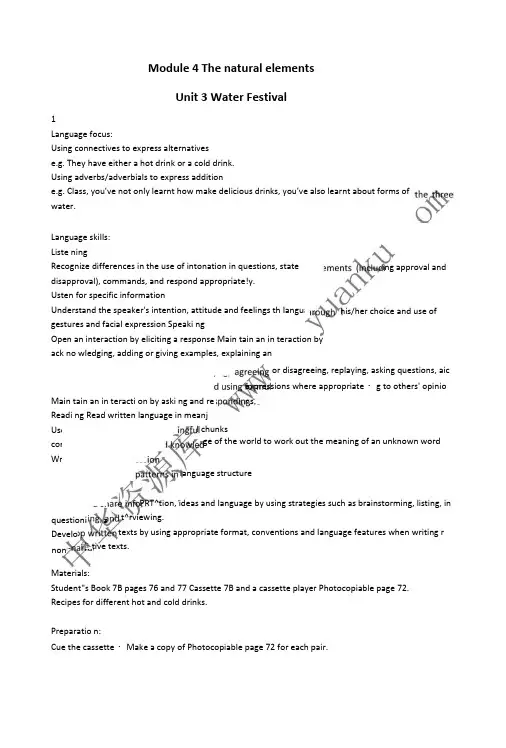
Module 4 The natural elementsUnit 3 Water Festival1Language focus:Using connectives to express alternatives e.g. They have either a hot drink or a cold drink. Using adverbs/adverbials to express additione.g. Class, you've not only learnt how make delicious drinks, you've also learnt about forms of water. Materials:Student"s Book 7B pages 76 and 77 Cassette 7B and a cassette player Photocopiable page 72. Recipes for different hot and cold drinks. Preparatio n:Cue the cassette ・ Make a copy of Photocopiable page 72 for each pair.Language skills: Liste ningRecognize differences in the use of intonation in questions, state disapproval), commands, and respond appropriate!y. Usten for specific informationUnderstand the speaker's intention, attitude and feelings th Ianguage, gestures and facial expression Speaki ngOpen an interaction by eliciting a response Main tain an in teraction by ack no wledging, adding or giving examples, explaining aning approval andMain tain an in teracti on by aski ng and resReadi ng Read written language in meanjUse visual clues, con text and and a complete expressi Recognize recurrent Writing Gather and shor disagreeing, replaying, asking questions, aic expressions where appropriate ・ g to others' opinions.questioni Develo I chunksge of the world to work out the meaning of an unknown word Ianguage structurePRT^tion, ideas and Ianguage by using strategies such as brainstorming, listing, int^rviewing.texts by using appropriate format, conventions and Ianguage features when writing r能tive texts.his/her choice and use ofanon二Pre-task preparationLanguage learning activity(This section aims at providing students with opportunities to practise the Ianguage/vocabulary needed or become familiar with the background for the task that follows・1. In troduce recipes of d iff ere nt hot and cold drinks to stude nts・ Ask students about the differe nt types of hot and cold drinks can make・ Write students' suggest!ons on the board・2.Play the recording: Look and read・ Students listen and follow in their books・3.Distribute a copy of Photocopiable page 72 to each pair. Students are required to write a recipefor making Apple and Peach Tea. Get students to discuss in pairs how they would make it, gived the pictures and words ・ The n they write their recipes.4.Invite a few paires to share their recipes with the rest of the class. Get each pair tqPhgc节their an swers with ano ther pair. Accept all reas on able an swers and give expla nations whe n n ecessary.5.Ask students to write recipes for their suggestions previously discussed・ You k students to think of other drinks they can make. Students can work individually, in pairs roups.6・ When students have finished their recipes, collect them and bind the her to make a recipe book.2Language focus:Asking 'Wh-7questions to find out various kinds of specific ViTormation about a person, object or an event・e.g. What happens when we boil water?Using conn ectives to show the time relatio tfetwee n two actio ns.e.g. When we freeze water; it turns into ice.Language skills:Liste ningRecognize difference^ disapproval), co ds;SpeakingOpenadd\cTse of intonation in question® statements (including approval and d respond appropriately.nby eliciting a response by asking questions or providing information on a topic・eracti on by ack no wledgi ng, agreei ng or disagreei ng, replyi ng, aski ng questio ns, giving examples, explaining and using formulaic expressions where appropriate・ Ma aiNan interaction by asking and responding to others' opinions・ Close an interaction by giving reasons.Readi ngMaintainRead written Ianguage in meaningful chunks.Use visual clues, con text and kno wledge of the world to work out the meaning of an unknown word and a complete expression・Recog nize recurrent patter ns in Ian guage structure.WritingGather and share information, ideas and Ianguage by using strategies such as brainstorming, listing, questioning, and interviewingPlan and orga nize information and ideas by deci ding on the sequence of conte nt. Develop written texts by presenting main and supporting ideas. Develop written texts by expressing own ideas and feelings ・ Materials:Student's Book 7B page 77 Workbook 7B page 41 Photocopiable page 73 Preparatio n:Make a copy of Photocopiable page 73 for each pair.Language skills: Liste ningRecog nize d iff ere nces in the use of int onation in questions, statements (in cludi ng approval and disapproval), comma nds, and resp ond appropriately.Indentify the main ideas of a new topic ・ Listen for specific information. Speaki ngUse appropriate intonation and stress, and vary volume, tone of voice, and speed to convey intended meanings and feelings.Maintai n an in teractio n by ack no wledgi ng, agreei ng or disagreei ng, replying, aski ng questio ns, adding or giving examples, explaining and using formulaic expressions where appropriateUsing thaintrQdyctqry 'there' to express facts. e.g ・ Therewere 100 millitres of water in the jug ・ Consolidatio nGrammar Practice Book 7B page 67Readi ng Read written Ianguage in meaningful chunks.Use visual clues, con text and kno wledge of the world to work out the meaning of an unknown word and a complete expression ・Recognize recurrent patter ns in Ian guage structure ・Materials:Student's Book 7B page 78 Cassette 7B and a cassette player A jug, a bowl, a cup and water.Preparatio n: Cue the cassette.Pre-task preparation Language learning activity(This section aims at providing students with opportunities to se the Ianguage/vocabulary needed or become familiar with the background for the task 史atlbjlows ・1. Ask students if they know any water games ・ Get st nt 》o explain the game, including the procedures and rules, to the rest of the class ・2. Play the recording: Think and do. Students I aihd follow in their books ・ If it is necessary, clarify the procedures and rules with the cl3. In vite two stude nts to come to the front ass and dem on strate the game ・4. Ask students: How can you get 90 millilitres of water in the jug? Give students time to answer this questio n. Then dem on strate it t 5・ You may invite students t the materials to class. H they dem on strate it. OffSgt of the class. me water games previously suggested. Get students to bring nts explain the procedures and rules to the rest of the class while nd guidance to the less able students.4 LanguagUsing the'ibti^luctory 'there 7 to express facts.were 50 millilitres of water in the bowl.tHH simple past tense to talk about past activities and states. e.g. There were 50 millilitres of water in the jug ・ Using the simple present tense to express simple truthse.g. Now there are only 20 millilitres of water in it.Language skills: Liste ningRecog nize d iff ere nces in the use of int onation in questions, statements (in cludi ng approval and disapproval), comma nds, and resp ond appropriately. Speaki ngUse appropriate intonation and stress, and vary volume, tone of voice, and speed to convey intended meanings and feelings.Open an interaction by eliciting a response.Maintain an in teracti on by ack no wledgi ng, agreei ng or disagreei ng, replyi ng, aski ng questio ns, adding or giving examples, explaining and using formulaic expressions where appropriate ・ Maintain an interaction by asking and responding to others' opinions Readi ngRead written Ianguage in meaningful chunks.Use visual clues, con text and kno wledge of the world to work out the meaning of an unknown word and a complete expressionRecognize recurrent patter ns in Ian guage structure. WritingGather and share information, ideas and Ianguage by using strategies such as brainstorn^g, listing, questioning, and interviewing.Develop written texts by expressing own ideas and feelings ・ Write out a piece of work by presenting writing using appro including ・illustrations, tables, charts where necessary Materials:Student's Book 7B page 79 Workbook 7B page 42 Photocopiable page 74A jug, a bowl, a cup and water 5Language focus: Asking "Wh 」沁 find out place, positi on or direction. e.g. Wheusually find this sign?Use adverl^/^Syerbials to express time/frequency ・ e ually find this sign near reservoirs and piers ・ laic expressions to express opinions.eg What a shame! Language skills: Liste ningRecog nize d iff ere nces in the use of intonation in questions, stateme nts (includi ng approval and disapproval), commands, and respond appropriate!y.and visual support7啓r each student.Preparatio n: Make a copy of Photocopiablej)Identify the main ideas of a new topic・Listen for specific informationSpeaki ngUse appropriate intonation and stress, and vary volume, tone of voice, and speed to convey intended meanings and feelings.Maintain an in teractio n by ack no wledgi ng, agreei ng or disagreei ng, replying, aski ng questio ns, adding or giving examples, explaining and using formulaic expressions where appropriate ・ Main tain an in teractio n by controlli ng participati on in an in teracti on or group activities such as taking one's turn at the right moment and recognizing others' desire to speak ・ Readi ng.Read written Ianguage in meaningful chunks.Use visual clues, con text and kno wledge of the world to work out the mea ning of an unknown word and a complete expression.Recognize recurrent patter ns in Ian guage structureLanguage focus:Asking z Wh J questions to find out place, positio n and directi on. e.g. Where do we find this sign? Using adverbs/adverbials to express time/frequencye.g. We usually find this sign in … using imperatives to express prohibitions. e.g. Diving is not allowed ・ Language skills:Materials:Student's Book 7B page 80 Cassette 7B and a cassette player Workbook 7B page 43 Preparatio n: Cue the cassette. Pre-task preparation Language learning activity(This section aims at providing students wit needed or become familiar with the backgortunities to practise the Ianguage/vocabulary or the task that follows ・1. Review the d iff ere nt places, such as: swimming pools, reservoirs, con structi on sites, beaches, etc. Ask stude nts: What signs do w e atjhese places? To elicit differ ent signs which stude nts know, and draw the sign on the board ・ Offer help to students 讦 they Get students to come up to are not sure what the si2. Play the recording: ^3. Invite some s ts match.4. Ask st match. 6汶and match. Students listen and follow in their books. role-play the characters and say the conversation in Read, think andcofne up with the procedures and rules for the matchi ng game in Read, think and dents' ideas on the board.Liste ningRecognize differences in the use of intonation in questions, statements, commands,and respond appropriate!y. Understand the speaker's intention, attitude and feelings through his/her choice and use of language, gestures and facial expressionSpeakingUse appropriate intonation and stress, and vary volume, tone of voice, and speed to convey inten ded mea nings and feeli ngs. Ope n an in teraction by eliciti ng a resp onse by aski ng questi ons or providing information on a topic.Maintain interactio n by ack no wledgi ng, agreei ng or disagreei ng, replyi ng, aski ng questions, or giving examples, explaining and using formulaic expressions where appropriate・ Readi ngRead written Ianguage in meaningful chunks.Use visual clues, con text and kno wledge of the world to work out the meaningand a complete expression. Recognize recurrent patterns in Ianguage structuMaterials:Student's Book 7B page 81Workbook 7B page 44Photocopiable pages 75 and 76A few boxesPreparatio n:Make a copy of Photocopiable pages 75and 76 foc^ch^roup・Pre-task preparation1.Introduce the different signs page 81 of the Student〃s Book to students. Ask students to read out each sign. Ask them: Where do^/^find$his sign? To elicit: We usually find this sign in/at/near …2.Ask students to think of gns that they know of, besides the ones on page 81 of the Stude nt"s Book ・Get stu tlVdraw and write the signs on paper. Tell students to in elude theirPost-task activit Work Conso Grahknown work 4signs when they play ng game.Practice Book 7B pages 70 and 75。
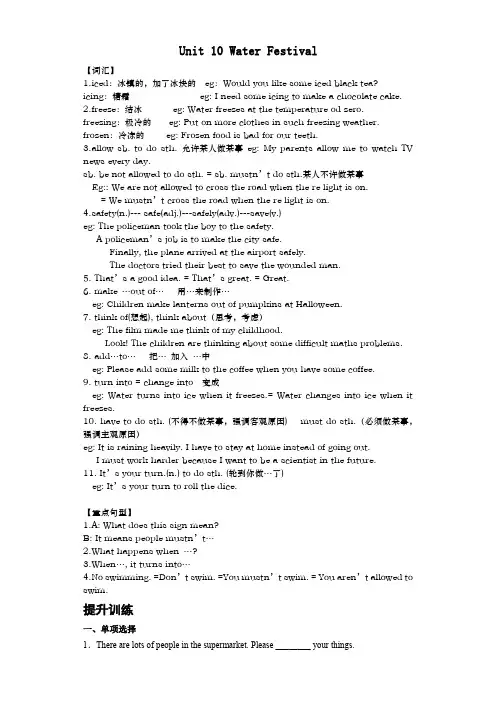
Unit 10 Water Festival【词汇】1.iced:冰镇的,加了冰块的eg:Would you like some iced black tea?icing:糖霜eg: I need some icing to make a chocolate cake. 2.freeze:结冰eg: Water freezes at the temperature od zero. freezing:极冷的eg: Put on more clothes in such freezing weather. frozen:冷冻的eg: Frozen food is bad for our teeth.3.allow sb. to do sth. 允许某人做某事eg: My parents allow me to watch TV news every day.sb. be not allowed to do sth. = sb. mustn’t do sth.某人不许做某事Eg:: We are not allowed to cross the road when the re light is on.= We mustn’t cross the road when the re light is on.4.safety(n.)--- safe(adj.)---safely(adv.)---save(v.)eg: The policeman took the boy to the safety.A policeman’s job is to make the city safe.Finally, the plane arrived at the airport safely.The doctors tried their best to save the wounded man.5. That’s a good idea. = That’s great. = Great.6. make …out of…用…来制作…eg: Children make lanterns out of pumpkins at Halloween.7. think of(想起), think about(思考,考虑)eg: The film made me think of my childhood.Look! The children are thinking about some difficult maths problems. 8. add…to…把…加入…中eg: Please add some milk to the coffee when you have some coffee.9. turn into = change into 变成eg: Water turns into ice when it freezes.= Water changes into ice when it freezes.10. have to do sth. (不得不做某事,强调客观原因) must do sth.(必须做某事,强调主观原因)eg: It is raining heavily. I have to stay at home instead of going out.I must work harder because I want to be a scientist in the future.11. It’s your turn.(n.) to do sth. (轮到你做…了)eg: It’s your turn to roll the dice.【重点句型】1.A: What does this sign mean?B: It means people mustn’t…2.What happens when …?3.When…, it turns into…4.No swimming. =Don’t swim. =You mustn’t swim. = You aren’t allowed to swim.提升训练一、单项选择1.There are lots of people in the supermarket. Please ________ your things.A.be careful with B.look at C.take photos of D.get on 2.—Is there a bank near here?—________. It’s ________ Center Street.A.Yes, there is; at B.Yes, there is; onC.No, there isn’t; at D.No, there isn’t; on3.—Let’s ________ to the zoo!—I’m sorry. I must ________ my homework first.A.going; do B.go; doingC.go; do D.going; doing4.If you’re interested in our business plan, ______ this number and ask for Ms. Lee. She’ll answer your questions.A.calling B.call C.and call D.to call 5.—________ silent (沉默的), please! You are in the library.—I’m sorry, madam.A.Keep B.To keep C.Keeping D.Kept6.The teacher often says, “_________ late.”A.Don’t B.Don’t be C.Not be D.Doesn’t 7.—What a sunny day! Why not go for a spring outing with us?— ________ . Let’s go.A.Better not B.That sounds great C.That’s all right D.I’m afraid not 8.—________ talk in the hallways.—________, Mrs. Zhou.A.Don’t; Thank you B.Can’t; Thank you C.No; SorryD.Don’t; Sorry二、短文填空阅读短文,在空白处填入一个适当的单词或用括号内所给词的正确形式填空,使短文通顺、连贯。

Module 4 The natural elementsUnit 3 Water Festival1Language focus:Using connectives to express alternativese.g. They have either a hot drink or a cold drink.Using adverbs/adverbials to express additione.g. Class, you’ve not only learnt how make delicious drinks, you’ve also learnt about the three forms of water.Language skills:ListeningRecognize differences in the use of intonation in questions, statements (including approval and disapproval), commands, and respond appropriately. Listen for specific informationUnderstand the speaker’s intention, attitude and feelings through his/her choice and use of language, gestures and facial expressionSpeakingOpen an interaction by eliciting a responseMaintain an interaction by acknowledging, agreeing or disagreeing, replaying, asking questions, adding or giving examples, explaining and using formulaic expressions where appropriate.Maintain an interaction by asking and responding to others’ opinions. ReadingRead written language in meaningful chunksUse visual clues, context and knowledge of the world to work out the meaningof an unknown word and a complete expressionRecognize recurrent patterns in language structureWritingGather and share information, ideas and language by using strategies such as brainstorming, listing, questioning, and interviewing.Develop written texts by using appropriate format, conventions and language features when writing non-narrative texts.Materials:Student’s Book 7B pages 76 and 77Cassette 7B and a cassette playerPhotocopiable page 72.Recipes for different hot and cold drinks.Preparation:Cue the cassette. Make a copy of Photocopiable page 72 for each pair.Pre-task preparationLanguage learning activity(This section aims at providing students with opportunities to practise the language/vocabulary needed or become familiar with the background for the task that follows.1. Introduce recipes of different hot and cold drinks to students. Ask students about the different types of hot and cold drinks can make. Write students’suggestions on the board.2. Play the recording: Look and read. Students listen and follow in their bo oks.3. Distribute a copy of Photocopiable page 72 to each pair. Students are required to write a recipe for making Apple and Peach Tea. Get students to discuss in pairs how they would make it, given the pictures and words. Then they write their recipes.4. Invite a few paires to share their recipes with the rest of the class. Get each pair to check their answers with another pair. Accept all reasonabl e answers and give explanations when necessary.5. Ask students to write recipes for their suggestions previously discussed. You may ask students to think of other drinks they can make. Students can work individually, in pairs or in groups.6. When students have finished their recipes, collect them and bind them together to make a recipe book.2Language focus:Asking ‘Wh-’ questions to find out various kinds of specific information about a person, object or an event.e.g. What happens when we boil water?Using connectives to show the time relationship between two actions.e.g. When we freeze water, it turns into ice.Language skills:ListeningRecognize differences in the use of intonation in questions, statements (including approval and disapproval), commands, and respond appropriately. SpeakingOpen an interaction by eliciting a response by asking questions or providinginformation on a topic.Maintain an interaction by acknowledging, agreeing or disagreeing, replying, asking questions, adding or giving examples, explaining and using formulaic expressions where appropriate.Maintain an interaction by asking and responding to others’ opinions. Close an interaction by giving reasons.ReadingRead written language in meaningful chunks.Use visual clues, context and knowledge of the world to work out the meaning of an unknown word and a complete expression.Recognize recurrent patterns in language structure.WritingGather and share information, ideas and language by using strategies such as brainstorming, listing, questioning, and interviewingPlan and organize information and ideas by deciding on the sequence of content. Develop written texts by presenting main and supporting ideas.Develop written texts by expressing own ideas and feelings.Materials:Student’s Book 7B page 77Workbook 7B page 41Photocopiable page 73Preparation:Make a copy of Photocopiable page 73 for each pair.Pre-task preparation1. Demonstrate boiling water turning into steam in class. Have students watch the demonstration and give brief explanation about each step of the demonstration.2. Ask students: What happens when we boil water/freeze water/ice melts? To elicit: When we boil water …/ When we freeze water … / When ice melts … You may ask more able students: What are the three forms of water?ConsolidationGrammar Practice Book 7B page 673Language focus:Using connectives to show the time relationship between two actions.e.g. When the jug full, it contains 100 millilitres of water.Using nouns/noun phrases to refer to quantity/units.e.g. 100 millilitres of water.Using modals to express obligation and prohibition.e.g. You must pour all the water into another object.Using the introductory ‘there’ to express facts.e.g. There were 100 millitres of water in the jug.Language skills:ListeningRecognize differences in the use of intonation in questions, statements (including approval and disapproval), commands, and respond appropriately. Indentify the main ideas of a new topic. Listen for specific information. SpeakingUse appropriate intonation and stress, and vary volume, tone of voice, and speed to convey intended meanings and feelings.Maintain an interaction by acknowledging, agreeing or disagreeing, replying, asking questions, adding or giving examples, explaining and using formulaic expressions where appropriateReadingRead written language in meaningful chunks.Use visual clues, context and knowledge of the world to work out the meaning of an unknown word and a complete expression.Recognize recurrent patterns in language structure.Materials:Student’s Book 7B page 78Cassette 7B and a cassette playerA jug, a bowl, a cup and water.Preparation:Cue the cassette.Pre-task preparationLanguage learning activity(This section aims at providing students with opportunities to practise the language/vocabulary needed or become familiar with the background for the task that follows.1. Ask students if they know any water games. Get students to explain the game, including the procedures and rules, to th e rest of the class.2. Play the recording: Think and do. Students listen and follow in their books. If it is necessary, clarify the procedures and rules with the class.3. Invite two students to come to the front of the class and demonstrate the game.4. Ask students: How can you get 90 millilitres of water in the jug? Give students time to answer this question. Then demonstrate it to the rest of the class.5. You may invite students to play some water games previously suggested. Get students to bring the materials to class. Have students explain the procedures and rules to the rest of the class while they demonstrate it. Offer help and guidance to the less able students.4Language focus:Using the introductory ‘there’ to express facts.e.g. There were 50 millilitres of water in the bowl.Using the simple past tense to talk about past activities and states.e.g. There were 50 millilitres of water in the jug.Using the simple present tense to express simple truthse.g. Now there are only 20 millilitres of water in it.Language skills:ListeningRecognize differences in the use of intonation in questions, statements (including approval and disapproval), commands, and respond appropriately. SpeakingUse appropriate intonation and stress, and vary volume, tone of voice, and speedto convey intended meanings and feelings.Open an interaction by eliciting a response.Maintain an interaction by acknowledging, agreeing or disagreeing, replying, asking questions, adding or giving examples, explaining and using formulaic expressions where appropriate.Maintain an interaction by asking and responding to others’ opinions ReadingRead written language in meaningful chunks.Use visual clues, context and knowledge of the world to work out the meaning of an unknown word and a complete expressionRecognize recurrent patterns in language structure.WritingGather and share information, ideas and language by using strategies such as brainstorming, listing, questioning, and interviewing.Develop written texts by expressing own ideas and feelings.Write out a piece of work by presenting writing using appropriate layout and visual support including illustrations, tables, charts where necessary.Materials:Student’s Book 7B page 79Workbook 7B page 42Photocopiable page 74A jug, a bowl, a cup and waterPreparation:Make a copy of Photocopiable page 74 for each student.5Language focus:Asking ‘Wh-’ questions to find out place, position or direction.e.g. Where do we usually find this sign?Use adverbs/adverbials to express time/frequency.e.g. We usually find this sign near reservoirs and piers.Use formulaic expressions to express opinions.e.g. What a shame!Language skills:ListeningRecognize differences in the use of intonation in questions, statements (including approval and disapproval), commands, and respond appropriately. Identify the main ideas of a new topic.Listen for specific informationSpeakingUse appropriate intonation and stress, a nd vary volume, tone of voice, and speed to convey intended meanings and feelings.Maintain an interaction by acknowledging, agreeing or disagreeing, replying, asking questions, adding or giving examples, explaining and using formulaic expressions where appropriate.Maintain an interaction by controlling participation in an interaction or group activities such as taking one’s turn at the right moment and recognizing others’desire to speak.Reading.Read written language in meaningful chunks.Use visual clues, context and knowledge of the world to work out the meaning of an unknown word and a complete expression.Recognize recurrent patterns in language structureMaterials:Student’s Book 7B page 80Cassette 7B and a cassette playerWorkbook 7B page 43Preparation:Cue the cassette.Pre-task preparationLanguage learning activity(This section aims at providing students with opportunities to practise the language/vocabulary needed or become familiar with the background for the task that follows.1. Review the different places, such as: swimming pools, reservoirs, construction sites, beaches, etc. Ask students: What signs do we see at these places? To elicit different signs which students know. Get students to come up to the front and draw the sign on the board. Offer help to students if they are not sure what the sign says.2. Play the recording: Read, think and match. Students listen and follow in their books.3. Invite some students to role-play the characters and say the conversation in Read, think and match.4. Ask students to come up with the procedures and rules for the matching game in Read, think and match. Write students’ ideas on the board.6Language focus:Asking ‘Wh-’ questions to find out place, position and direction.e.g. Where do we find this sign?Using adverbs/adverbials to express time/frequencye.g. We usually find this sign in …using imperatives to express prohibitions.e.g. Diving is not allowed.Language skills:ListeningRecognize differences in the use of intonation in questions, statements, commands, and respond appropriately. Understand the speaker’s intention, attitude and feelings through his/her choice and use of language, gestures and facial expressionSpeakingUse appropriate intonation and stress, and vary volume, tone of voice, and speed to convey intended meanings and feelings. Open an interaction by eliciting a response by asking questions or providing information on a topic.Maintain interaction by acknowledging, agreeing or disagreeing, replying, asking questions, adding or giving examples, explaining and using formulaic expressions where appropriate.ReadingRead written language in meaningful chunks.Use visual clues, context and knowledge of the world to work out the meaningof an unknown work and a complete expression. Recognize recurrent patterns in language structure.Materials:Student’s Book 7B page 81Workbook 7B page 44Photocopiable pages 75 and 76A few boxesPreparation:Make a copy of Photocopiable pages 75 and 76 for each group.Pre-task preparation1. Introduce the different signs page 81 of the Student’s Book to students. Ask students to read out each sign. Ask them: Where do we fi nd this sign? To elicit: We usually find this sign in/at/near …2. Ask students to think of other signs that they know of, besides the ones on page 81 of the Student’s Book. Get students to dr aw and write the signs on paper. Tell students to include their signs when they play the matching game.Post-task activityWorkbook page 44ConsolidationGrammar Practice Book 7B pages 70 and 75。

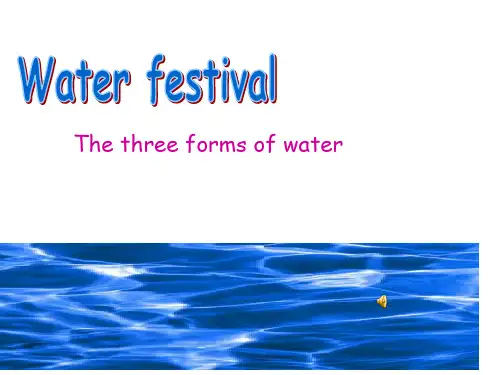
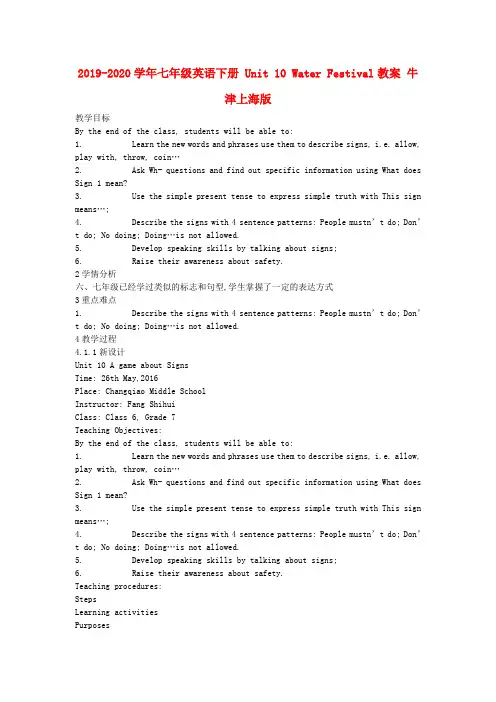
2019-2020学年七年级英语下册 Unit 10 Water Festival教案牛津上海版教学目标By the end of the class, students will be able to:1. Learn the new words and phrases use them to describe signs, i.e. allow, play with, throw, coin…2. Ask Wh- questions and find out specific information using What does Sign 1 mean?3. Use the simple present tense to express simple truth with This sign means…;4. Describe the signs with 4 sentence patterns: People mustn’t do; Don’t do; No doing; Doing…is not allowed.5. Develop speaking skills by talking about signs;6. Raise their awareness about safety.2学情分析六、七年级已经学过类似的标志和句型,学生掌握了一定的表达方式3重点难点1. Describe the signs with 4 sentence patterns: People mustn’t do; Don’t do; No doing; Doing…is not allowed.4教学过程4.1.1新设计Unit 10 A game about SignsTime: 26th May,2016Place: Changqiao Middle SchoolInstructor: Fang ShihuiClass: Class 6, Grade 7Teaching Objectives:By the end of the class, students will be able to:1. Learn the new words and phrases use them to describe signs, i.e. allow, play with, throw, coin…2. Ask Wh- questions and find out specific information using What does Sign 1 mean?3. Use the simple present tense to express simple truth with This sign means…;4. Describe the signs with 4 sentence patterns: People mustn’t do; Don’t do; No doing; Doing…is not allowed.5. Develop speaking skills by talking about signs;6. Raise their awareness about safety.Teaching procedures:StepsLearning activitiesPurposesI. warm-upTo watch a short video and to answer ‘What did you see in the video?’To look at the picturesTo warm up and to help the Ss relax and to get started on the topic of signs. To remind the Ss of the fact that we have signs around us all the time.II. Pre-task preparationsTo look at a sign and answer ‘What does it mean?’To learn that we can also use expression ‘Doing… is not allowed’To describe the two signs with four sentence patternsTo review what they have learnt beforeTo let Ss know that they can use four different sentence patterns for describing signs.To let Ss practice the four different sentence patterns for describing signs.III. While-task proceduresTo fill in the blanks according to the given signTo correct the mistakes according the given signTo learn new words and phrases ‘toy, throw, coin, play with’. And to look at pictures of signs on the screen and try to tell the meaning of each sign by using four different sentence patterns.Talk in groups to describe the given signsTo have a small competition about the signsTo let Ss practice the four different sentence patternsTo let Ss practice moreTo help Ss get familiar with four sentence patterns for expressing the meaning of signs.To motivate Ss to participate with more enthusiasm.To help Ss get more familiar with the sentence patterns about the signs and make them more activeIV. Post-task activitiesTo make dialogues with their partners and act these dialogues outTo help improve Ss’ skills of using English in real life and to help Ss understand the meanings of the signs better and raise awareness for safety.V. AssignmentOral work:1. Read and recite the text.2. Act out the given dialogues.Written work:1. Draw a sign and write what it means.Blackboard DesignUnit 10 A Game about signsallowdiveplay withtoythrowcoin-What does sign… mean-It means: 1. People mustn’t do...2. No doing…3. Don’t do..4. Doing… is not allowed.。


第10讲Unit10 Water Festival上海牛津沪教版七年级(下)同步讲义Unit10 Water Festival适用学科初中英语适用年级初中一年级适用区域上海课时时长(分钟)120分钟(一对一)知识点知识点1:本单元词汇知识点2:词组知识点3:句型知识点4:祈使句的用法知识点5:感动动词的用法知识点6:动名词的用法教学目标知识:学生能够基本掌握7年级上册Unit10中的词汇、词组、句型及语法。
方法:牢记各个知识点的用法,归纳总结异同点,通过习题加强巩固。
能力:熟练掌握各种词汇的用法;具备准确判断词性及转换的能力;熟练掌握祈使句的肯定形式与否定形式;熟练运用动名词的能力。
教学重点词性转换;形容词副词级别;动名词用法教学难点动名词的用法教学过程一、课堂导入教师讲述一个与本节课题目有关的英文小故事,引出今日所要讲解的知识点,然后让学生简单梳理一下所涉及的问题,带着问题学习本节课的内容。
二、复习预习教师引导学生复习上节课学的重点内容,检测单词的用法,(以提问、回顾的形式进行),针对上节课的作业进行讲评、订正、答疑,并通过英文小故事导入本节课所要学习的新知识。
三、知识讲解1. 知识点一:重点单词1)iced [a?s]【词性】adj.【词义】冰镇的;加冰块的【易混淆点】frozen 结冻的iced 冰镇的【经典例句】I can make iced soft drinks for my classmates.我能为我的班里同学制作冰镇软饮料。
2)punch [p?nt?]【词性】n.【词义】潘趣酒;宾治酒【经典例句】I can make iced fruit punch for my classmates.我能为我的班里同学制作冰镇宾治酒。
3)form [f?:m]【词性1】n.【词义1】形态;形式【词性2】v.【词义2】形成【易混淆点】form 形式from 来自【经典例句】We can see the three forms of water.我们可以看到水的三种形式。

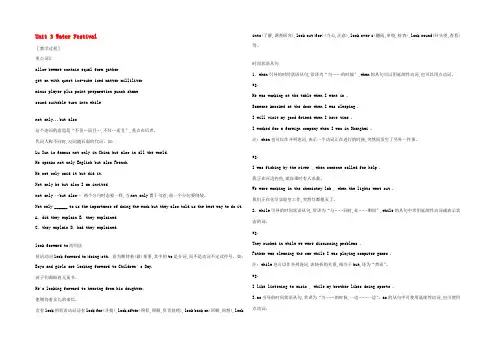
Unit 3 Water Festival[教学过程]重点词汇allow beware contain equal form gatherget on with quest ice-cube iced matter milliliterminus player plus point preparation punch shamesound suitable turn into whilenot only...but also这个连词的意思是“不但…而且…,不仅…而且”,重点在后者。
代词人称不同时,动词随后面的代词。
如:Lu Xun is famous not only in China but also in all the world.He speaks not only English but also French.He not only said it but did it.Not only he but also I am invitednot only …but also…两个分句时态要一样,当not only置于句首,前一个分句要倒装。
Not only ______ to us the importance of doing the work but they also told us the best way to do it.A. did they explainB. they explainedC. they explainD. had they explainedlook forward to的用法短语动词look forward to(doing)sth. 意为期待着(做)某事,其中的to是介词,而不是动词不定式符号。
如:Boys and girls are looking forward to Children’s Day.孩子们渴盼着儿童节。
He's looking forward to hearing from his daughter.他期待着女儿的来信。
Module 4 The natural elementsUnit 3 Water Festival1Language focus:Using connectives to express alternativese.g. They have either a hot drink or a cold drink.Using adverbs/adverbials to express additione.g. Class, you’ve not only learnt how make delicious drinks, you’ve also learnt about the three forms of water.Language skills:ListeningRecognize differences in the use of intonation in questions, statements (including approval and disapproval), commands, and respond appropriately.Listen for specific informationUnderstand the speaker’s intention, attitude and feelings through his/her choice and use of language, gestures and facial expressionSpeakingOpen an interaction by eliciting a responseMaintain an interaction by acknowledging, agreeing or disagreeing, replaying, asking questions, adding or giving examples, explaining and using formulaic expressions where appropriate. Maintain an interaction by asking and responding to others’ opinions.ReadingRead written language in meaningful chunksUse visual clues, context and knowledge of the world to work out the meaning of an unknown word and a complete expressionRecognize recurrent patterns in language structureWritingGather and share information, ideas and language by using strategies such as brainstorming, listing, questioning, and interviewing.Develop written texts by using appropriate format, conventions and language features when writing non-narrative texts.Materials:Student’s Book 7B pages 76 and 77Cassette 7B and a cassette playerPhotocopiable page 72.Recipes for different hot and cold drinks.Preparation:Cue the cassette. Make a copy of Photocopiable page 72 for each pair.Pre-task preparationLanguage learning activity(This section aims at providing students with opportunities to practise the language/vocabulary needed or become familiar with the background for the task that follows.1. Introduce recipes of different hot and cold drinks to students. Ask students about the different types of hot and cold drinks can make. Write students’ suggestions on the board.2. Play the recording: Look and read. Students listen and follow in their books.3. Distribute a copy of Photocopiable page 72 to each pair. Students are required to write a recipe for making Apple and Peach Tea. Get students to discuss in pairs how they would make it, given the pictures and words. Then they write their recipes.4. Invite a few paires to share their recipes with the rest of the class. Get each pair to check their answers with another pair. Accept all reasonable answers and give explanations when necessary.5. Ask students to write recipes for their suggestions previously discussed. You may ask students to think of other drinks they can make. Students can work individually, in pairs or in groups.6. When students have finished their recipes, collect them and bind them together to make a recipe book.2Language focus:Asking ‘Wh-’ questions to find out various kinds of specific information about a person, object or an event.e.g. What happens when we boil water?Using connectives to show the time relationship between two actions.e.g. When we freeze water, it turns into ice.Language skills:ListeningRecognize differences in the use of intonation in questions, statements (including approval and disapproval), commands, and respond appropriately.SpeakingOpen an interaction by eliciting a response by asking questions or providing information on a topic.Maintain an interaction by acknowledging, agreeing or disagreeing, replying, asking questions, adding or giving examples, explaining and using formulaic expressions where appropriate. Maintain an interaction by asking and responding to others’ opinions.Close an interaction by giving reasons.ReadingRead written language in meaningful chunks.Use visual clues, context and knowledge of the world to work out the meaning of an unknown word and a complete expression.Recognize recurrent patterns in language structure.WritingGather and share information, ideas and language by using strategies such as brainstorming,listing, questioning, and interviewingPlan and organize information and ideas by deciding on the sequence of content.Develop written texts by presenting main and supporting ideas.Develop written texts by expressing own ideas and feelings.Materials:Student’s Book 7B page 77Workbook 7B page 41Photocopiable page 73Preparation:Make a copy of Photocopiable page 73 for each pair.Pre-task preparation1. Demonstrate boiling water turning into steam in class. Have students watch the demonstration and give brief explanation about each step of the demonstration.2. Ask students: What happens when we boil water/freeze water/ice melts? To elicit: When we boil water …/ When we freeze water … / When ice melts … You may ask more able students: What are the three forms of water?ConsolidationGrammar Practice Book 7B page 673Language focus:Using connectives to show the time relationship between two actions.e.g. When the jug full, it contains 100 millilitres of water.Using nouns/noun phrases to refer to quantity/units.e.g. 100 millilitres of water.Using modals to express obligation and prohibition.e.g. You must pour all the water into another object.Using the introductory ‘there’ to express facts.e.g. There were 100 millitres of water in the jug.Language skills:ListeningRecognize differences in the use of intonation in questions, statements (including approval and disapproval), commands, and respond appropriately.Indentify the main ideas of a new topic. Listen for specific information.SpeakingUse appropriate intonation and stress, and vary volume, tone of voice, and speed to convey intended meanings and feelings.Maintain an interaction by acknowledging, agreeing or disagreeing, replying, asking questions,adding or giving examples, explaining and using formulaic expressions where appropriate ReadingRead written language in meaningful chunks.Use visual clues, context and knowledge of the world to work out the meaning of an unknown word and a complete expression.Recognize recurrent patterns in language structure.Materials:Student’s Book 7B page 78Cassette 7B and a cassette playerA jug, a bowl, a cup and water.Preparation:Cue the cassette.Pre-task preparationLanguage learning activity(This section aims at providing students with opportunities to practise the language/vocabulary needed or become familiar with the background for the task that follows.1. Ask students if they know any water games. Get students to explain the game, including the procedures and rules, to the rest of the class.2. Play the recording: Think and do. Students listen and follow in their books. If it is necessary, clarify the procedures and rules with the class.3. Invite two students to come to the front of the class and demonstrate the game.4. Ask students: How can you get 90 millilitres of water in the jug? Give students time to answer this question. Then demonstrate it to the rest of the class.5. You may invite students to play some water games previously suggested. Get students to bring the materials to class. Have students explain the procedures and rules to the rest of the class while they demonstrate it. Offer help and guidance to the less able students.4Language focus:Using the introductory ‘there’ to express facts.e.g. There were 50 millilitres of water in the bowl.Using the simple past tense to talk about past activities and states.e.g. There were 50 millilitres of water in the jug.Using the simple present tense to express simple truthse.g. Now there are only 20 millilitres of water in it.Language skills:ListeningRecognize differences in the use of intonation in questions, statements (including approval and disapproval), commands, and respond appropriately.Use appropriate intonation and stress, and vary volume, tone of voice, and speed to convey intended meanings and feelings.Open an interaction by eliciting a response.Maintain an interaction by acknowledging, agreeing or disagreeing, replying, asking questions, adding or giving examples, explaining and using formulaic expressions where appropriate. Maintain an interaction by asking and responding to others’ opinionsReadingRead written language in meaningful chunks.Use visual clues, context and knowledge of the world to work out the meaning of an unknown word and a complete expressionRecognize recurrent patterns in language structure.WritingGather and share information, ideas and language by using strategies such as brainstorming, listing, questioning, and interviewing.Develop written texts by expressing own ideas and feelings.Write out a piece of work by presenting writing using appropriate layout and visual support including illustrations, tables, charts where necessary.Materials:Student’s Book 7B page 79Workbook 7B page 42Photocopiable page 74A jug, a bowl, a cup and waterPreparation:Make a copy of Photocopiable page 74 for each student.5Language focus:Asking ‘Wh-’ questions to find out place, position or direction.e.g. Where do we usually find this sign?Use adverbs/adverbials to express time/frequency.e.g. We usually find this sign near reservoirs and piers.Use formulaic expressions to express opinions.e.g. What a shame!Language skills:ListeningRecognize differences in the use of intonation in questions, statements (including approval and disapproval), commands, and respond appropriately.Identify the main ideas of a new topic.Listen for specific informationUse appropriate intonation and stress, and vary volume, tone of voice, and speed to convey intended meanings and feelings.Maintain an interaction by acknowledging, agreeing or disagreeing, replying, asking questions, adding or giving examples, explaining and using formulaic expressions where appropriate. Maintain an interaction by controlling participation in an interaction or group activities such as taking one’s turn at the right moment and recognizing others’ desire to speak.Reading.Read written language in meaningful chunks.Use visual clues, context and knowledge of the world to work out the meaning of an unknown word and a complete expression.Recognize recurrent patterns in language structureMaterials:Student’s Book 7B page 80Cassette 7B and a cassette playerWorkbook 7B page 43Preparation:Cue the cassette.Pre-task preparationLanguage learning activity(This section aims at providing students with opportunities to practise the language/vocabulary needed or become familiar with the background for the task that follows.1. Review the different places, such as: swimming pools, reservoirs, construction sites, beaches, etc. Ask students: What signs do we see at these places? To elicit different signs which students know. Get students to come up to the front and draw the sign on the board. Offer help to students if they are not sure what the sign says.2. Play the recording: Read, think and match. Students listen and follow in their books.3. Invite some students to role-play the characters and say the conversation in Read, think and match.4. Ask students to come up with the procedures and rules for the matching game in Read, think and match. Write students’ ideas on the board.6Language focus:Asking ‘Wh-’ questions to find out place, position and direction.e.g. Where do we find this sign?Using adverbs/adverbials to express time/frequencye.g. We usually find th is sign in …using imperatives to express prohibitions.e.g. Diving is not allowed.Language skills:ListeningRecognize differences in the use of intonation in questions, statements, commands, and respond appropriately. Understand the speaker’s intenti on, attitude and feelings through his/her choice and use of language, gestures and facial expressionSpeakingUse appropriate intonation and stress, and vary volume, tone of voice, and speed to convey intended meanings and feelings. Open an interaction by eliciting a response by asking questions or providing information on a topic.Maintain interaction by acknowledging, agreeing or disagreeing, replying, asking questions, adding or giving examples, explaining and using formulaic expressions where appropriate. ReadingRead written language in meaningful chunks.Use visual clues, context and knowledge of the world to work out the meaning of an unknown work and a complete expression. Recognize recurrent patterns in language structure. Materials:Student’s Book 7B page 81Workbook 7B page 44Photocopiable pages 75 and 76A few boxesPreparation:Make a copy of Photocopiable pages 75 and 76 for each group.Pre-task preparation1. Introduce the different signs page 81 of the Student’s Book to students. Ask studen ts to read out each sign. Ask them: Where do we find this sign? To elicit: We usually find this sign in/at/near …2. Ask students to think of other signs that they know of, besides the ones on page 81 of the Student’s Book. Get students to draw and write t he signs on paper. Tell students to include their signs when they play the matching game.Post-task activityWorkbook page 44ConsolidationGrammar Practice Book 7B pages 70 and 75学:优≦中$考*,网。